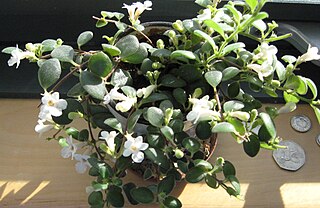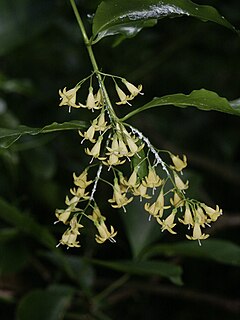Sir Everard Ferdinand im Thurn was an author, explorer, botanist, photographer and British colonial administrator. He was Governor of Fiji in the years 1904–1910.

Episcia is a genus of flowering plants in the African violet family, Gesneriaceae. The ten species it contains are native to the tropical regions of Central and South America. The species are perennial herbaceous plants characterized by a stoloniferous habit, red flowers, and frequently have marked or patterned leaves. Episcias are sometimes called flame violets.

Kohleria is a New World genus of the flowering plant family Gesneriaceae. The plants are generally tropical herbs or subshrubs with velvety stems and foliage and brightly colored flowers with spots or markings in contrasting colors. They are rhizomatous and commonly include a period of dormancy in their growth cycle. The genus was revised in 1992 and was then recognized as having 19 species distributed in Central America and South America. phylogenetic in 2005 indicated that the epiphytic genus Capanea is derived from within Kohleria, and the two species of Capanea were subsequently transferred to Kohleria. The genus Pearcea is closely related.

Sacciolepis is a genus of plants in the grass family. Cupscale grass is a common name for plants in this genus.

Codonanthe is a genus of mainly epiphytic plants in the family Gesneriaceae, endemic to the Atlantic Forest of Brazil. The botanical name comes from the Ancient Greek for 'bellflower'. They have white or pale pink flowers and somewhat fleshy leaves. In 2013, the genus was reduced in size when more than half of the species were transferred to Codonanthopsis. They can be grown as houseplants, particularly in hanging baskets. Artificial crosses with Nematanthus hybrids have produced the hybrid genus × Codonatanthus.

Chiococca is a genus of flowering plants in the family Rubiaceae. It currently holds 23 species that are native to Florida, Texas, Mexico, Central America, much of South America, the West Indies, and the islands of Galápagos and Fernando de Noronha.

Episcia cupreata is a species of perennial plant in the family Gesneriaceae that is found in Brazil, Colombia, and Venezuela. Its common name is flame violet, although this name may also refer to other species of the genus Episcia. A number of hybrids have been created.
Johann Adam Philipp Hepp was a German physician and lichenologist.
Aulonemia trianae is a species of bamboo of the genus Aulonemia. It is part of the grass family and endemic to Latin America., with its native range in Columbia to Venezuela.

Corytoplectus is a genus in the plant family Gesneriaceae. Plants from Corytoplectus are found in Bolivia, Brazil North, Colombia, Ecuador, Guyana, Mexico Southwest, Peru, Venezuela, in the cloud-forests of the high cordillera. The genus contains c. 12 species. The genus differs from the closely related Alloplectus in having an erect umbellate inflorescence and berries. The type species is C. capitatus.

Columnea microcalyx, called the goldfish plant or orange columnea, is a species of flowering plant in the genus Columnea, native to southeast Mexico, Central America, Columbia and Venezuela. Its cultivar 'Superba' has gained the Royal Horticultural Society's Award of Garden Merit.

Solenophora is a genus of flowering plants in the family Gesneriaceae, native to Central America and southern Mexico. Most of its species have limited, local distributions, but Solenophora calycosa is widespread.

Strychnos toxifera, called bush rope and devil doer, is a species of flowering plant in the genus Strychnos, native to Costa Rica, Panama, Colombia, Ecuador, Venezuela, the Guianas, Brazil, and Bolivia. It is the principal source of calabash or gourd curare.
Amalophyllon is a genus of flowering plants belonging to the family Gesneriaceae.
Everardia is a genus of flowering plants belonging to the family Cyperaceae.

Eucodonia is a genus of flowering plants belonging to the family Gesneriaceae.
Donnellsmithia is a genus of flowering plants belonging to the family Apiaceae.
Mandirola is a genus of flowering plants belonging to the family Gesneriaceae.
Pachycaulos is a genus of flowering plants belonging to the family Gesneriaceae. Its only species is Pachycaulos nummularia. Its native range is Southeastern Mexico to Peru.
Ernestia is a genus of plant in family Melastomataceae.










